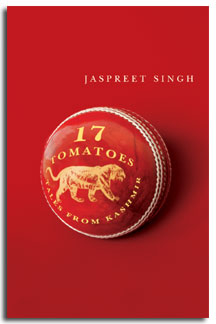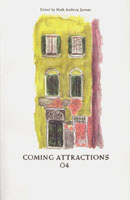Rust and Bone
by Craig Davidson
Penguin, 2005
Yesterday's People
by Goran Simic
Biblioasis, 2005
17 Tomatoes
by Jaspreet Singh
Vehicule, 2004
Coming Attractions 04
edited by Mark Anthony Jarman
featuring Neil Smith, Marureen Bilerman and Jaspreet Singh
Oberon, 2004
Reviewed by Michael Bryson
As I sit down to write this (Dec. 3,
2005), the Toronto Maple Leafs have just lost to the San Jose Sharks
5-4. The game featured Joe Thorton in his second game in San Jose, after
being traded away from Boston. The Leafs lifted themselves to a 3-1 lead
by the first intermission, but their on-again off-again commitment to
team defence was off-again in the second period, and the Sharks pulled
ahead, never to surrender the lead.
I would also note that today's Globe
and Mail included an article by Michael Posner titled "The
great fiction crash of 2005." Posner quoted from an article in this
month's Quill & Quire by Toronto literary agent Denise
Bukowski titled "Why your novel isn't selling." Bukowski
wrote:
What do we do about a popular culture
where the market for SUVs (until recently, anyway) and computers and
$100 running shoes and all kinds of fancy electronics and
entertainment and communication gizmos seems to be unlimited, but the
book market is stagnating?
Posner confirms there is pressure in
the fiction market: "international publishers are giving every new
novel greater scrutiny." Though his article also provides sales
figures for both Miriam Toews' A Complicated Kindness (200,000)
and Mary Lawson's Crow Lake (150,000).
 I
have a simple (and just-kidding) answer to why the book market is
stagnating: hockey's back. I
have a simple (and just-kidding) answer to why the book market is
stagnating: hockey's back.
I also have a simple answer to why your
novel isn't selling: who cares?
This here is a review of four short
story collections, all of which will be lucky to sell even 1,000 copies.
Craig Davidson's Rust and Bone is
put out by a large house (Penguin) and definitely has the best chance to
make headway in the marketplace. That said, right here I'm going to stop
considering the financial angle and turn my attention to the only thing
that should really concern us: the words on the page.
Here's the beginning of Davidson's
title story:
Twenty-seven bones make up the human
hand. Lunate and capitate and navicular, scaphoid and triquetrum, the
tiny horn-shaped pisiforms of the outer wrist. Though differing in
shape and density each is smoothly aligned and flush-fitted, lashed by
a meshwork of ligatures running under the skin. All vertebrates share
a similar set of bones, and all bones grow out of the same tissues: a
bird's wing, a whale's dorsal fin, a gecko's pad, your own hand. Some
primates got more -- gorilla's got thirty-two bones, five in each
thumb. Humans, twenty-seven.
Now that you've read that, look again
at the cover of the book posted above. That's about all I think I should
need to tell you about this book. The writing is precise, sharp with
detail; the narratives of these eight short stories are laced with
violence. This is surely one of the most dynamic and forceful debut
collections to ever appear in Canada. I don't think I've read another
Canlit book like it.
Over thirty years ago, Margaret Atwood
argued in Survival: A Thematic Guide to Canadian Literature that
narratives about victims dominated the Canadian literary imagination.
Davidson turns that argument completely on its head. The stories in Rust
and Bone rotate without exception around what it means to have
power, not what it means to be without it (the possible exception is the
collection's final story, "An Apprentice's Guide to Modern
Magic" in which the children of a magician who used the ruse of a
magic trick to abandon them in childhood seek out their aged father.
However, while this story is told from the point of view of the victims,
it maintains faith with the other stories in the collection, because the
father -- the powerful character -- remains unapologetic).
None of the characters in this book
ever says, "Might is right" (or mentions Nietzsche), but many
clearly believe it -- and others struggle with similar concepts or codes. One
character, who breeds fighting dogs, narrates this:
I remember what the dogman from whom
I'd purchased my first pit bull told me: These dogs are bred for a
mean utility. They are bred to fight and live only for the fight. It's
all they know. I wonder at a life so singular of purpose, a
utilitarian existence no different than that of a hammer or
shovel.
("A Mean Utility")
 In
Yesterday's People, Goran Simic presents stories more familiar in
tone to Canadian readers. Perhaps it would be accurate to say, more
familiar in tone to short story readers generally. These are stories
about the civil war that brutalized the former Yugoslavia in the
early-1990s. These are stories about citizen-soldiers and other victims
of absurd violence. In
Yesterday's People, Goran Simic presents stories more familiar in
tone to Canadian readers. Perhaps it would be accurate to say, more
familiar in tone to short story readers generally. These are stories
about the civil war that brutalized the former Yugoslavia in the
early-1990s. These are stories about citizen-soldiers and other victims
of absurd violence.
In prose showing the ongoing influence
of Chekhov, Simic paints portraits of ordinary people caught in
extraordinary circumstances. If Davidson's stories show an interest in
the struggles of the powerful, Simic illustrates his tremendous
sensitivities to the victims of the world's grand schemes. Simic has
produced stories that can be read beside Hemingway's tales of World War
I ... as well as the work of Kakfa and the post-communists: Orwell,
Kundera, et al. That is, the canon of war literature is already thick;
Simic continues to show there is room yet for more additions.
 This is a strong debut collection that
deserves a readership. Simic is the poet of Immigrant
Blues and From Sarajevo With Sorrow.
He is as big-hearted and serious a writer as we have in Canada today.
His autobiography is interesting, yes; the output of his imagination,
however, is what ought to interest us -- and find an audience many times
its current size. This is a strong debut collection that
deserves a readership. Simic is the poet of Immigrant
Blues and From Sarajevo With Sorrow.
He is as big-hearted and serious a writer as we have in Canada today.
His autobiography is interesting, yes; the output of his imagination,
however, is what ought to interest us -- and find an audience many times
its current size.
Jaspreet
Singh's 17 Tomatoes, like Simic's collection, is another example
of how conflict abroad has enriched Canadian literature. Subtitled
"Tales from Kashmir," Singh's book (to quote the back cover)
"is a series of linked stories that revolve around two Sikh boys
coming of age in an Indian army camp." The result is something more
than an exploration of character; it is an exploration of a community --
similar to the effect achieved in Sherwood Anderson's Winesburg, Ohio.
This quick critical assessment of this
collection would be incomplete, however, if I didn't add that there was
something about this book that failed to satisfy. The writing is
certainly excellent. The characters are clearly drawn, and the
narratives clever and often insightful. Perhaps it was the persistent
child's-eye view? The forced simplicity of certain accounts? I'm not
sure.
 The
Jaspreet Singh encountered in Coming Attractions 04 is certainly
not simple, and I appreciated the three stories he has in this
collection much more. Singh has a PhD in chemical engineering, and in
his stories in Coming Attractions 04 that education is on full
display. He is clearly a writer of many gifts. 17 Tomatoes
showcased tenderness. Singh's three stories in Coming Attractions 04 play
on the intersection between science and art: The
Jaspreet Singh encountered in Coming Attractions 04 is certainly
not simple, and I appreciated the three stories he has in this
collection much more. Singh has a PhD in chemical engineering, and in
his stories in Coming Attractions 04 that education is on full
display. He is clearly a writer of many gifts. 17 Tomatoes
showcased tenderness. Singh's three stories in Coming Attractions 04 play
on the intersection between science and art:
The scientist was so good-looking we
all found it impossible to work in the lab. Therefore, we started
working in the evenings and over weekends. Many times we had to skip
Sunday church. We stopped entertaining kids and spouses and business
clients. We sacrificed Super Bowl games. There was no other option.
We were almost offended by his
beauty. He could bring the entire lab to a halt with his hazy lamellar
smile.
("Spellbound")
Singh's prose doesn't have the
gymnastic deftness of Davidson's. His stories also commonly dwell in
realms more abstract than boxing, dog fighting, sex addiction or
abandoned children. Neil Smith's stories in Coming Attractions 04
likewise tend toward high concept, though they remain rooted in
heart-wrenching human emotion.
"The Butterfly Box" shows how
the roles fathers and sons play for each other can become inverse over
time. "Isolettes" takes us into the Neonatal Intensive Care
Unit. "Green Florescent Protein" pretends to be a story about
two teenage boys sorting out their relationship to each other; in fact,
it is something else entirely ... it's a clipped 21st-century version of
Frankenstein.
Neil Smith's stories were among the
best I've read in the past number of years. They tread familiar
territory, but they do it in a way strongly original. If Simic's stories
troll the extraordinary for the ordinary, Smith's stories do the
opposite -- they take the quotidian and extract the unusual.
Maureen Bilerman is the past winner of
the New Brunswick Literary Competition, and her contributions to Coming
Attractions 04 show that the vein of gritty down-East realism -- a
la Lynn Coady et
al -- is far from fully mined. They are excellent examples of the genre.
Michael Bryson is the
publisher and editor of The Danforth Review. His story "Six Million
Million Miles" appeared in 05: Best Canadian Stories (Oberon
Press).
|